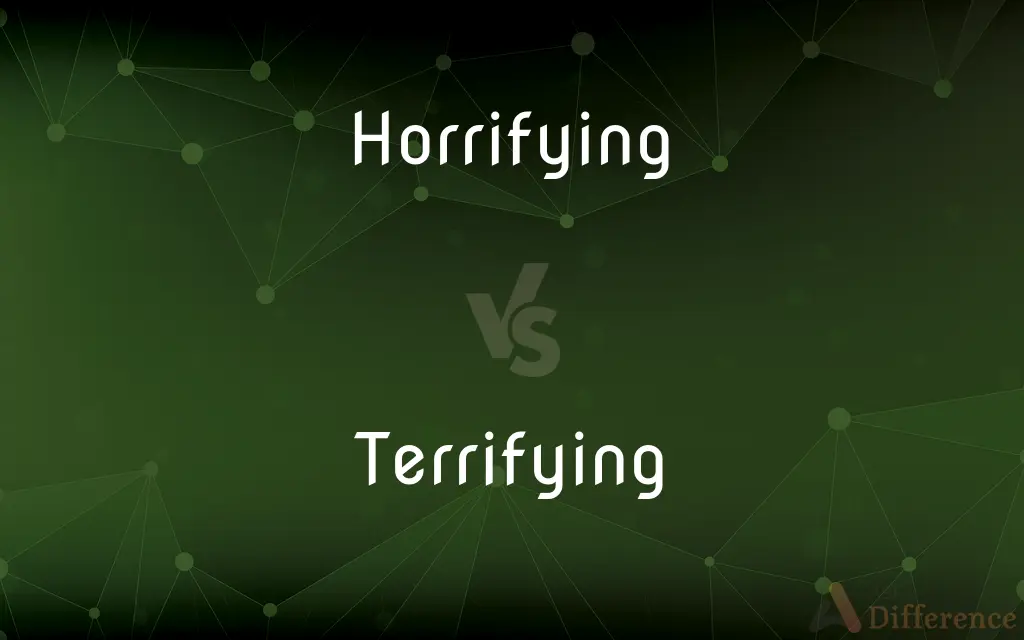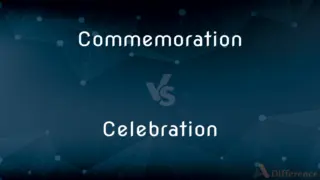Horrifying vs. Terrifying — What's the Difference?
By Maham Liaqat & Urooj Arif — Updated on March 9, 2024
Horrifying refers to something that causes horror or great shock, often related to grotesque or shocking sights, while terrifying implies causing extreme fear, typically through the threat of danger or the unknown.

Difference Between Horrifying and Terrifying
Table of Contents
ADVERTISEMENT
Key Differences
Horrifying experiences or images are often associated with a sense of revulsion or disgust, stemming from sights or events that are particularly gruesome or shocking. Terrifying, on the other hand, involves intense fear or anxiety, often related to perceived threats, danger, or overwhelming situations.
While horrifying elements might elicit a response of horror and shock, often related to the macabre or morally repugnant, terrifying elements induce a state of extreme fear or dread, potentially causing panic or immobilization. The key distinction lies in the nature of the emotional response: horror versus fear.
In literature and media, horrifying content might involve graphic depictions of violence or disturbing themes, designed to shock or disturb the audience. Terrifying content, however, focuses on creating suspense and fear, often through threats, suspenseful situations, or the unknown.
The reaction to something horrifying might include a desire to look away or escape the shocking sight, while the reaction to something terrifying is often a primal fear response, such as the fight-or-flight instinct.
Comparison Chart
Emotional Response
Shock and revulsion
Extreme fear and anxiety
ADVERTISEMENT
Common Triggers
Grotesque sights, moral transgressions
Perceived threats, danger, the unknown
Typical Reactions
Disgust, horror, avoidance
Panic, dread, fight-or-flight response
Use in Media
Graphic violence, disturbing themes
Suspense, threats, psychological fear
Outcome
Moral shock, disturbance
Heightened alertness, fear of harm
Compare with Definitions
Horrifying
Horrifying scenes can cause viewers to recoil in horror.
The horrifying images from the disaster scene left everyone in shock.
Terrifying
Terrifying experiences induce intense feelings of dread.
The terrifying sound in the darkness made her heart race.
Horrifying
Often related to gruesome or shocking sights.
The movie's horrifying makeup effects made the monsters look shockingly real.
Terrifying
Can cause physiological responses associated with fear.
The terrifying encounter with the wild animal triggered a rush of adrenaline.
Horrifying
The natural response might be to look away or escape the source of horror.
The horrifying scene was so graphic that many viewers covered their eyes.
Terrifying
Uses the unknown or impending danger to evoke fear.
The suspenseful buildup to the climactic scene was utterly terrifying.
Horrifying
In media, it aims to leave a lasting impression through shock value.
The director used horrifying elements to challenge the audience's comfort zones.
Terrifying
Often linked to the perception of imminent threat or harm.
The thought of being lost in the wilderness at night was terrifying.
Horrifying
Can involve actions or events that are deeply unsettling on a moral level.
The news report uncovered horrifying details of the crime, causing public outcry.
Terrifying
Aims to create a lingering sense of fear or unease.
The novel's terrifying concept of a dystopian future left readers pondering long after finishing it.
Horrifying
To cause to feel horror
The citizens were horrified by the bombings. The guest was horrified at the rudeness of what he had said.
Terrifying
To fill with terror; make deeply afraid
"She was terrified that he would lie to her" (Jodi Picoult).
Horrifying
To cause unpleasant surprise to; shock
"I ... passed a mirror ... &.
Was horrified at the shabbiness of my hat" (Margaret Suckley).
Terrifying
To drive or force by arousing fear
"The few who survived had long ago been terrified into complete intellectual surrender" (George Orwell).
Horrifying
Present participle of horrify
Terrifying
Frightening or intimidating.
Horrifying
Tending to inspire horror; that horrifies; horrific.
Terrifying
Of a formidable nature; terrific
Horrifying
Provoking horror;
An atrocious automobile accident
A frightful crime of decapitation
An alarming, even horrifying, picture
War is beyond all words horrible
An ugly wound
Terrifying
Present participle of terrify
Terrifying
Causing extreme terror;
A terrifying wail
Common Curiosities
How do filmmakers use horrifying and terrifying elements differently in horror movies?
Filmmakers use horrifying elements to shock and disturb the audience with graphic content, while terrifying elements are used to create suspense and fear through threats and the unknown.
Can something be both horrifying and terrifying?
Yes, an event or situation can be both horrifying and terrifying if it combines elements of shock and disgust with intense fear or dread.
Can the same event be horrifying to one person and terrifying to another?
Yes, personal experiences, sensitivities, and fears can influence whether an individual perceives an event as more horrifying or terrifying.
How do people typically cope with horrifying or terrifying experiences?
Coping mechanisms can vary widely, including seeking support from others, using relaxation techniques, engaging in therapy, or avoiding triggers.
Is the reaction to horrifying content more intense than to terrifying content?
The intensity of reaction can vary based on personal sensitivities; some may find horrifying content more disturbing due to its shock value, while others may find terrifying content more intense due to fear.
What are some common physical reactions to terrifying situations?
Common reactions include increased heart rate, sweating, trembling, and the urge to flee or fight, all associated with the body's fight-or-flight response.
Are there any benefits to experiencing terrifying or horrifying content in a safe environment?
Experiencing such content in a safe context, like movies or haunted houses, can provide a controlled thrill, help individuals confront fears, or offer a cathartic release.
Can literature be as terrifying or horrifying as visual media?
Yes, literature can evoke powerful horrifying or terrifying responses through descriptive language, allowing readers' imaginations to create vivid and disturbing or frightening scenarios.
How do cultural differences affect perceptions of horrifying and terrifying content?
Cultural background can significantly impact what individuals find horrifying or terrifying, influenced by societal norms, beliefs, and media consumption habits.
Is it possible to become desensitized to horrifying or terrifying stimuli?
Repeated exposure to such stimuli can lead to desensitization, reducing the intensity of emotional responses over time, though this can vary widely among individuals.
Share Your Discovery

Previous Comparison
Commemoration vs. Celebration
Next Comparison
Spacecraft vs. SpaceshipAuthor Spotlight
Written by
Maham LiaqatCo-written by
Urooj ArifUrooj is a skilled content writer at Ask Difference, known for her exceptional ability to simplify complex topics into engaging and informative content. With a passion for research and a flair for clear, concise writing, she consistently delivers articles that resonate with our diverse audience.














































